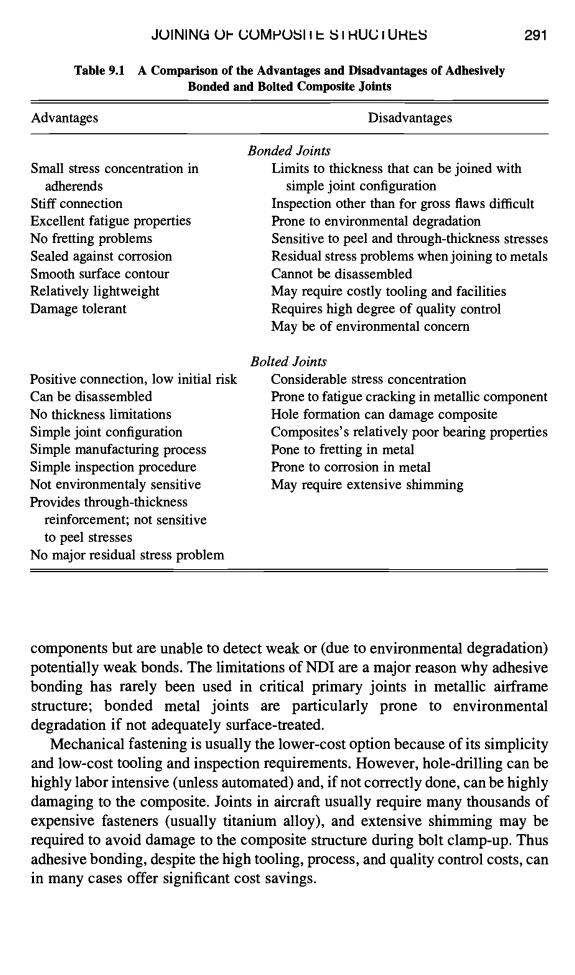正在加载图片...

JUINING UF CUMPUSIIE SIHUCIUHES 291 Table 9.1 A Comparison of the Advantages and Disadvantages of Adhesively Bonded and Bolted Composite Joints Advantages Disadvantages Bonded Joints Small stress concentration in Limits to thickness that can be joined with adherends simple joint configuration Stiff connection Inspection other than for gross flaws difficult Excellent fatigue properties Prone to environmental degradation No fretting problems Sensitive to peel and through-thickness stresses Sealed against corrosion Residual stress problems when joining to metals Smooth surface contour Cannot be disassembled Relatively lightweight May require costly tooling and facilities Damage tolerant Requires high degree of quality control May be of environmental concern Bolted Joints Positive connection,low initial risk Considerable stress concentration Can be disassembled Prone to fatigue cracking in metallic component No thickness limitations Hole formation can damage composite Simple joint configuration Composites's relatively poor bearing properties Simple manufacturing process Pone to fretting in metal Simple inspection procedure Prone to corrosion in metal Not environmentaly sensitive May require extensive shimming Provides through-thickness reinforcement;not sensitive to peel stresses No major residual stress problem components but are unable to detect weak or(due to environmental degradation) potentially weak bonds.The limitations of NDI are a major reason why adhesive bonding has rarely been used in critical primary joints in metallic airframe structure;bonded metal joints are particularly prone to environmental degradation if not adequately surface-treated. Mechanical fastening is usually the lower-cost option because of its simplicity and low-cost tooling and inspection requirements.However,hole-drilling can be highly labor intensive(unless automated)and,if not correctly done,can be highly damaging to the composite.Joints in aircraft usually require many thousands of expensive fasteners (usually titanium alloy),and extensive shimming may be required to avoid damage to the composite structure during bolt clamp-up.Thus adhesive bonding,despite the high tooling,process,and quality control costs,can in many cases offer significant cost savings.Table 9.1 J(.,)INING L)P L;L)MP(..,)~I I I:: ~51 HUG I UHI::S A Comparison of the Advantages and Disadvantages of Adhesively Bonded and Bolted Composite Joints 291 Advantages Disadvantages Small stress concentration in adherends Stiff connection Excellent fatigue properties No fretting problems Sealed against corrosion Smooth surface contour Relatively lightweight Damage tolerant Positive connection, low initial risk Can be disassembled No thickness limitations Simple joint configuration Simple manufacturing process Simple inspection procedure Not environmentaly sensitive Provides through-thickness reinforcement; not sensitive to peel stresses No major residual stress problem Bonded Joints Limits to thickness that can be joined with simple joint configuration Inspection other than for gross flaws difficult Prone to environmental degradation Sensitive to peel and through-thickness stresses Residual stress problems when joining to metals Cannot be disassembled May require costly tooling and facilities Requires high degree of quality control May be of environmental concern Bolted Joints Considerable stress concentration Prone to fatigue cracking in metallic component Hole formation can damage composite Composites' s relatively poor bearing properties Pone to fretting in metal Prone to corrosion in metal May require extensive shimming components but are unable to detect weak or (due to environmental degradation) potentially weak bonds. The limitations of NDI are a major reason why adhesive bonding has rarely been used in critical primary joints in metallic airframe structure; bonded metal joints are particularly prone to environmental degradation if not adequately surface-treated. Mechanical fastening is usually the lower-cost option because of its simplicity and low-cost tooling and inspection requirements. However, hole-drilling can be highly labor intensive (unless automated) and, if not correctly done, can be highly damaging to the composite. Joints in aircraft usually require many thousands of expensive fasteners (usually titanium alloy), and extensive shimming may be required to avoid damage to the composite structure during bolt clamp-up. Thus adhesive bonding, despite the high tooling, process, and quality control costs, can in many cases offer significant cost savings